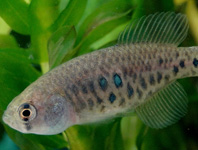Abstract
A new species of Austrolebias is described from the middle course of the Rio Camaquã, Laguna dos Patos system, Rio Grande do Sul, Brazil. The new species belongs to the Austrolebias alexandri species group, which is distinguished from the remaining congeners by the presence of a dark gray pectoral fin with bright blue iridescence in males. The new species is distinguished from all remaining species of the A. alexandri species group by the following combination of characters: presence of well-defined bright blue bars on the flank in males, shorter caudal fin length in males and females, contact organs in the first three rays of the pectoral fin in males, one to two post-optic neuromasts (rarely three), basihyal width of 50% of the length, and basihyal cartilage about 50–60% of the basihyal length. The recognition of this new species belonging to the A. alexandri group endemic of the middle course of Rio Camaquã and the recent discovery of Austrolebias bagual in the same general region reinforces the claim of the middle Rio Camaquã basin as an area of endemism for annual fishes and as such, a priority area for conservation in southern Brazil.
References
Alonso, F., Calviño, P.A., Terán, G.G. & García, I. (2016) Geographical distribution of Austrolebias monstrosus (Huber, 1995), A. elongatus (Steindachner, 1881) and A. vandenbergi (Huber, 1995) (Teleostei: Cyprinodontiformes), with comments on the biogeography and ecology of Rivulidae in Pampasic and Chaco floodplains. Check List, 12 (4), 1945.
https://doi.org/10.15560/12.4.1945
Calviño, P.A. (2006) Austrolebias toba (Cyprinodontiformes: Rivulidae), una especie nueva de pez anual de la Argentina. Revista del Museo Argentino de Ciencias Naturales, 7 (2), 183–190.
Costa, W.J.E.M. (1995) Pearl killifishes—the Cynolebiatinae: systematics and biogeography of the Neotropical annual fish subfamily. TFH Publications, Neptune City, 128 pp.
Costa, W.J.E.M. (2002) The Austrolebias alexandri species group: a taxonomical revision of an annual fish clade (Cyprinodontiformes: Rivulidae) in southern Brazil. Comunicações do Museu de Ciências e Tecnologia da PUCRS, Série Zoologia, 15, 87–111.
Costa, W.J.E.M. (2006) The South American annual killifish genus Austrolebias (Teleostei: Cyprinodontiformes: Rivulidae): phylogenetic relationships, descriptive morphology and taxonomic revision. Zootaxa, 1213, 1-–162.
Costa, W.J.E.M. (2010) Historical biogeography of Cynolebiasine annual killifishes inferred from dispersal-vicariance analisys. Journal of Biogeography, 37, 1995–2004.
https://doi.org/10.1111/j.1365-2699.2010.02339.x
Costa, W.J.E.M. & CHEFFE, M.M. (2005) Austrolebias univentripinnis sp. nov. (Teleostei: Cyprinodontiformes: Rivulidae): a new annual killifish from the Mirim Lagoon basin, southern Brazil. Zootaxa, 1052, 41–48.
https://doi.org/10.11646/zootaxa.1052.1.4Hoedeman, J.J. (1958) The frontal scalation patter in some groups of toothcarps (Pisces, Cyprinodontiformes). Bulletin of Aquatic Biology, 1, 23–28.
International Commission of Zoological Nomenclature (2017) Notice of new applications to the commission (cases 3745–3752). Bulletin of Zoological Nomenclature, 74, 54.
https://doi.org/10.21805/bzn.v74.a017IUCN Standards and Petitions Subcommittee (2011) Guidelines for Using the IUCN Red List Categories and Criteria, Version 9.0, Standards and Petitions Subcommittee, 87 pp. Available from: http://www.iucnredlist.org/documents/RedListGuidelines.pdf (accessed 20 March 2016)
Nielsen, D.T.B. & Pillet, D. (2015) Austrolebias accorsii, a new annual fish (Cyprinodontiformes: Rivulidae: Cynolebiatinae) from the upper Río Grande basin, Amazon basin, Bolivia. Aqua, International Journal of Ichthyology, 21 (4), 172–179.
Nobre, C.A., Cavalcanti, I.F.A., Gan, M.A., Nobre, P., Kayano, M.T., Vadlamudi, B.R., Bonatti, J.P., Satyamurty, P., Uvo, C.B., Cohen, J.C., Silva, J.F., Marschal, C. & Moura, A.D. (1986) Aspects of dynamic climatology of Brazil. Clima análise, 1986, 1–125.
Taylor, W.R. & Van Dyke, G.C. (1985) Revised procedures for staining and clearing small fishes and other vertebrates for bone and cartilage study. Cybium, 9, 107–119.
Van Der Laan, R., Eschmeyer, W.N. & Fricke, R. (2014) Family-group names of Recent fishes. Zootaxa, 3882 (1), 1–230.
https://doi.org/10.11646/zootaxa.3882.1.1
Volcan, M.V., Lanés, L.E.K. & Gonçalves, Â.C. (2014) Austrolebias bagual, a new species of annual fish (Cyprinodontiformes: Rivulidae) from Southern Brazil. Aqua, International Journal of Ichthyology, 20, 3–14.
Volcan, M.V., Lanés, L.E.K., Gonçalves, Â.C. & Guadagnin, D.L. (2015) Annual fishes (Rivulidae) from Southern Brazil: A broad-scale assessment of their diversity and conservation. In: Berois, N., García, G. & De Sá, R.O. (Org.), Annual Fishes: Life History Strategy, Diversity, and Evolution. CRC Press Taylor & Francis group, New York, pp. 185–206.
https://doi.org/10.1201/b19016-14
Volcan, M.V., Gonçalves, Â.C. & Lanés, L.E.K. (2017) First record of blackfin pearlfish Austrolebias nigripinnis (Regan, 1912) (Cyprinodontiformes, Cynolebiidae) from Brazil. Zootaxa, 4254 (3), 387–390.
https://doi.org/10.11646/zootaxa.4254.3.9

